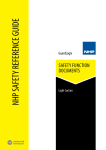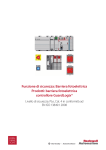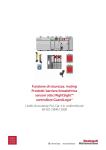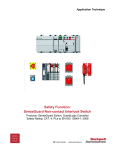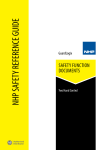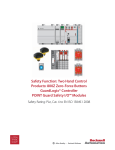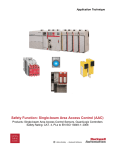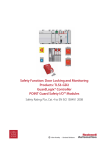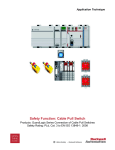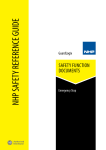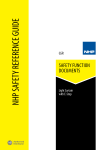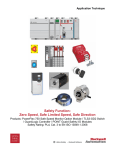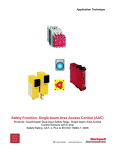Download Light Curtain with Muting Safety Function
Transcript
NHP SAFETY REFERENCE GUIDE GuardLogix SAFETY FUNCTION DOCUMENTS Light Curtain with Muting Safety Function Documents: GuardLogix Light Curtain with Muting RightSight™ Optical Sensors / GuardLogix® Controller Safety Rating: PLe, Cat. 4 to EN ISO 13849.1 2008 Table of Contents: Introduction 6-41 Important User Information 6-41 Safety Function Realization 6-42 General Safety Information 6-42 Setup and Wiring 6-45 Configuration 6-47 Programming 6-52 Falling Edge Reset 6-54 Calculation of the Performance Level 6-54 Verification and Validation Plan 6-56 Additional Resources 6-59 NHP Safety Reference Guide > Safety Function Documents: GSR 6A-42 Safety Function Documents: GuardLogix Light Curtain with Muting RightSight™ Optical Sensors / GuardLogix® Controller Safety Rating: PLe, Cat. 4 to EN ISO 13849.1 2008 Introduction Important User Information This Safety Function application note explains how to wire, configure, and program a Compact GuardLogix® controller and POINT Guard I/O™ module to monitor a 440L GuardShield® light curtain in a muting application. If a demand is placed on the light curtain when it is not muted, or a fault is detected in the monitoring circuit, the GuardLogix controller de-energizes the final control device, in this case, a redundant pair of 100S contactors. Solid state equipment has operational characteristics differing from those of electromechanical equipment. Safety Guidelines for the Application, Installation and Maintenance of Solid State Controls (publication SGI-1.1 available from your local Rockwell Automation® sales office or online at http://www. rockwellautomation.com/literature) describes some important differences between solid state equipment and hard-wired electromechanical devices. Because of this difference, and also because of the wide variety of uses for solid state equipment, all persons responsible for applying this equipment must satisfy themselves that each intended application of this equipment is acceptable. If the light curtain is muted, then the demand on the light curtain will be ignored if the muting sensors and light curtain are broken in the proper order. This example uses a Compact GuardLogix controller, but is applicable to any GuardLogix controller. This example uses a 440L GuardShield light curtain, but is applicable to light curtains that pulse tests the OSSD1 and OSSD2 outputs. This example uses RightSight optical sensors, but is applicable to any sensors that can be wired into Rockwell Automation safety inputs in mode that provides a HI signal when not blocked. The SISTEMA calculations shown later in this document would have to be re-calculated using the actual products. In no event will Rockwell Automation, Inc. be responsible or liable for indirect or consequential damages resulting from the use or application of this equipment. The examples and diagrams in this manual are included solely for illustrative purposes. Because of the many variables and requirements associated with any particular installation, Rockwell Automation, Inc. cannot assume responsibility or liability for actual use based on the examples and diagrams. No patent liability is assumed by Rockwell Automation, Inc. with respect to use of information, circuits, equipment, or software described in this manual. Reproduction of the contents of this manual, in whole or in part, without written permission of Rockwell Automation, Inc., is prohibited. NHP Safety Reference Guide > Safety Function Documents: GSR 6A-43 Safety Function Documents: GuardLogix Light Curtain with Muting RightSight™ Optical Sensors / GuardLogix® Controller Safety Rating: PLe, Cat. 4 to EN ISO 13849.1 2008 Safety Function Realization: Risk Assessment The required performance level is the result of a risk assessment and refers to the amount of the risk reduction to be carried out by the safety-related parts of the control system. Part of the risk reduction process is to determine the safety functions of the machine. For the purposes of this document the assumed required performance level is Category 4, PLe. Throughout this manual, when necessary, we use notes to make you aware of safety considerations. Light Curtain Muting Safety Function The light curtain has muting functionality in this example. There is no muting override in this example. Safety Function Requirements General Safety Information Contact Rockwell Automation to find out more about our safety risk assessment services. Interrupting the light curtain will stop and prevent hazardous motion by removal of power to the motor. Upon resetting the light curtain, hazardous motion and power to the motor will not resume until a secondary action (start button depressed) occurs. Muting of the light curtain is done to allow automatically fed material to enter the area. Multiple sensors are configured to detect the incoming material and initiate the muting function. Faults at the light curtain, muting sensors, wiring terminals or safety controller will be detected before the next safety demand. The safe distance location of the light curtain must be established such that the hazardous motion must be stopped before the user can reach the hazard. The safety function in this example is capable of connecting and interrupting power to motors rated up to 9A, 600VAC. The safety function will meet the requirements for Category 4, Performance Level “e” (Cat 4, PLe), per ISO 13849-1, and SIL3 per IEC 62061, and control reliable operation per ANSI B11.19. NHP Safety Reference Guide > Safety Function Documents: GSR 6A-44 Safety Function Documents: GuardLogix Light Curtain with Muting RightSight™ Optical Sensors / GuardLogix® Controller Safety Rating: PLe, Cat. 4 to EN ISO 13849.1 2008 Functional Safety Description Bill of Material Hazardous motion is interrupted or prevented by interrupting the light curtain. The 440L light curtain is wired to a pair of safety inputs of a 1734-IB8S module. The RightSight muting sensors are wired to inputs on the 1734-IB8S module as well. The I/O module is connected via CIP Safety over an EtherNet/ IP network to the Compact GuardLogix® safety controller, 1768L43S. This application example uses these components. The safety code in the safety processor monitors the status of the safety input using the pre-certified safety instruction ‘Dual Channel Input Stop’ (DCS). The output of the DCS, along with the two (2) muting sensors, is used as an input into the TSAM (two sensor asymmetrical muting) function block to handle the muting safety function. When all safety input interlocks are satisfied, no faults are detected, and the reset push button is pressed, a second certified function block called Configurable Redundant Output (CROUT) controls and monitors feedback for a pair of 100S redundant contactors. In summary, when the un-muted Light Curtain is blocked, the contactors drop out. When the Light Curtain is unblocked, and the reset button is pressed, the contactors are energized. A properly muted light curtain can be broken without dropping out the safety contactors. When the light curtain is muted, the muting lamp will be energized. Cat. No. Description Quantity 440L-P4JL0640YD GuardShield™ Safety Light Curtain, Res 14mm, Pt Ht 640mm, 64 Beams, Integrated Laser Alignment 1 42EF-B1KBBE-F4 Diffuse Backgroun Suppression, Dark Operate, PNP photoelectric sensor, HI when target absent 2 889D-F4AC-2 DC Micro (M12), Female, Straight, 4-Pin, PVC Cable, Yellow, Unshielded, 22AWG, 2 meter 3 889D-F8AB-2 DC Micro (M12), Female, Straight, 8-Pin, PVC Cable, Yellow, Unshielded, 24AWG, 2 meter 1 800FM-G611MX10 800F Reset Push Button - Metal, Guarded, Blue, R, Metal Latch Mount, 1 N.O. Contact(S), Standard 1 100S-C09ZJ23C Bulletin 100S-C - Safety Contactors 2 1768-ENBT CompactLogix™ EtherNet/IP Bridge Module 1 1768-L43S Compact GuardLogix Processor, 2.0 MB standard memory, 0.5 MB safety memory 1 1768-PA3 Power Supply, 120/240 VAC Input, 3.5 A @ 24V DC 1 1769-ECR Right End Cap/Terminator 1 1734-AENT 24V DC Ethernet Adapter 1 1734-TB Module Base with Removable IEC Screw Terminals 4 1734-IB8S POINT Guard Safety Input Module 1 1734-OB8S POINT Guard Safety Output Module 1 1783-US05T Stratix 2000™ Unmanaged Ethernet Switch 1 800T-QTH24G Pilot Light, 24VDC 2 NHP Safety Reference Guide > Safety Function Documents: GSR 6A-45 Safety Function Documents: GuardLogix Light Curtain with Muting RightSight™ Optical Sensors / GuardLogix® Controller Safety Rating: PLe, Cat. 4 to EN ISO 13849.1 2008 Functional Safety Description Bill of Material Hazardous motion is interrupted or prevented by interrupting the light curtain. The 440L light curtain is wired to a pair of safety inputs of a 1734-IB8S module. The RightSight muting sensors are wired to inputs on the 1734-IB8S module as well. The I/O module is connected via CIP Safety over an EtherNet/ IP network to the Compact GuardLogix® safety controller, 1768L43S. This application example uses these components. The safety code in the safety processor monitors the status of the safety input using the pre-certified safety instruction ‘Dual Channel Input Stop’ (DCS). The output of the DCS, along with the two (2) muting sensors, is used as an input into the TSAM (two sensor asymmetrical muting) function block to handle the muting safety function. When all safety input interlocks are satisfied, no faults are detected, and the reset push button is pressed, a second certified function block called Configurable Redundant Output (CROUT) controls and monitors feedback for a pair of 100S redundant contactors. In summary, when the un-muted Light Curtain is blocked, the contactors drop out. When the Light Curtain is unblocked, and the reset button is pressed, the contactors are energized. A properly muted light curtain can be broken without dropping out the safety contactors. When the light curtain is muted, the muting lamp will be energized. Cat. No. Description Quantity 440L-P4JL0640YD GuardShield™ Safety Light Curtain, Res 14mm, Pt Ht 640mm, 64 Beams, Integrated Laser Alignment 1 42EF-B1KBBE-F4 Diffuse Backgroun Suppression, Dark Operate, PNP photoelectric sensor, HI when target absent 2 889D-F4AC-2 DC Micro (M12), Female, Straight, 4-Pin, PVC Cable, Yellow, Unshielded, 22AWG, 2 meter 3 889D-F8AB-2 DC Micro (M12), Female, Straight, 8-Pin, PVC Cable, Yellow, Unshielded, 24AWG, 2 meter 1 800FM-G611MX10 800F Reset Push Button - Metal, Guarded, Blue, R, Metal Latch Mount, 1 N.O. Contact(S), Standard 1 100S-C09ZJ23C Bulletin 100S-C - Safety Contactors 2 1768-ENBT CompactLogix™ EtherNet/IP Bridge Module 1 1768-L43S Compact GuardLogix Processor, 2.0 MB standard memory, 0.5 MB safety memory 1 1768-PA3 Power Supply, 120/240 VAC Input, 3.5 A @ 24V DC 1 1769-ECR Right End Cap/Terminator 1 1734-AENT 24V DC Ethernet Adapter 1 1734-TB Module Base with Removable IEC Screw Terminals 4 1734-IB8S POINT Guard Safety Input Module 1 1734-OB8S POINT Guard Safety Output Module 1 1783-US05T Stratix 2000™ Unmanaged Ethernet Switch 1 800T-QTH24G Pilot Light, 24VDC 2 NHP Safety Reference Guide > Safety Function Documents: GSR 6A-46 Safety Function Documents: GuardLogix Light Curtain with Muting RightSight™ Optical Sensors / GuardLogix® Controller Safety Rating: PLe, Cat. 4 to EN ISO 13849.1 2008 Setup and Wiring For detailed information on installing and wiring, refer to the product manuals listed in the Additional Resources. System Overview The 1734-IB8S input module monitors OSSD1 and OSSD2 from the 440L light curtain, as well as the two RightSight muting sensors. If muting is not active and the Light Curtain is blocked, OSSD1 and OSSD2 go LO, and the controller will react by dropping out the safety contactors. Note that the Clear Area (CA) lamp is wired to test output 1 in this example. This is not required for functional safety. This lamp could be wired to a standard output module. Safe Distance Calculation The user will need to perform a calculation using this formula to determine the distance between the light curtain and the hazard. The user will need to use values based on their application; rather then the example calculation shown here: S = (K * T) + C The 440L has onboard diagnostics to dynamically test the signal wiring for shorts to 24VDC and channel to channel shorts. If a fault occurs, either or both OSSD1 and OSSD2 will be set LO, and the controller will react by dropping out the safety contactors. K = 63 inches per second (constant from B11.19-1990) Shorts to 0V DC (and wire off) will be seen as an open circuit by the 1734-IB8S input module and the controller will react by dropping out the safety contactors. If the inputs remain discrepant for longer than the discrepancy time, then the function block (DCS) in the controller will declare a fault. Only after the fault is cleared and the light curtain is cycled (blocked, then unblocked) will the function block reset. Stopping time (T) for this example is a summation of the following: The muting sensors are HI when the sensors are not blocked. If any fault occurs, such as a wire off, that cause one of the muting sensors to go LO in an improper muting sequence, then the controller will react by dropping out the safety contactors. Safety Task Period Only if the muting sensors and light curtain are blocked in the proper sequence will muting be active. When muting is active, the muting lamp will be energized. If the muting lamp is not drawing any current (due to a broken wire or burnt out bulb) the TSAM diagnostic code will indicate as such. This diagnostic is available because the muting sensor is wired from a test output that can be configured for MUTING LAMP (test outputs 1 and 3 on a 1734-IB8S module). The final control device in this case is a pair of 100S safety contactors, K1 and K2. The contactors are controlled by a 1734-OBS safety output module. The contactors are wired in a redundant series configuration. A feedback circuit is wired through the N/O contacts and back to an input on the 1734IB8S module to monitor the contactors for proper operation. The contactors cannot restart if the feedback circuit is not in the correct state. The system has individual reset buttons for resetting faults and safety outputs. Note that the reset buttons and the contactor feedback circuit are all wired to the 1734-IB8S module in this example. This is not required for functional safety. These three (3) inputs could be wired to a standard input module. T = stopping time C=D epth Penetration Factor = 1 inch (for 14mm resolution; from documentation) a) Light Curtain delay = 25ms (from documentation) b) 1734-IB8S module delay = 16ms (from documentation) c) Input Module Connection delay d) Safety Controller delay, Safety Task Watchdog, e) Output Module Connection delay f) 1734-OB8S delay = 6ms (from documentation) g) Contactor response time = 15ms (from documentation) h)Actual Machine stop time = assume 900ms for this example C - T he Input Module connection delay defaults to 4 x RPI If we assume a RPI of 10ms; the maximum delay = 40ms E - The Output Module connection delay defaults to 3 x RPI If we assume a RPI of 10ms; the maximum delay = 30ms The worst case reaction time may be calculated assuming there is only a single fault in the control system. This means that only the higher of the two connection delay values shown above needs to be included in the Time calculation. For this example, 40 ms is used; and the 30 is excluded. If you wish to account for multiple faults occurring at the same time; use both values in the calculation. D – t he safety controller delay is a combination of the safety task period plus the safety task watchdog. The watchdog accounts for the possibility that the safety code runs right up to, but does not trip the watchdog. The safety task period accounts for the possibility that the asynchronous scan just ended when the input changed state. For this example, lets assume: Safety Task Period = 10ms Safety Task Watchdog = 5ms NHP Safety Reference Guide > Safety Function Documents: GSR 6A-47 Safety Function Documents: GuardLogix Light Curtain with Muting RightSight™ Optical Sensors / GuardLogix® Controller Safety Rating: PLe, Cat. 4 to EN ISO 13849.1 2008 Safe Distance Calculation cont. Safe Distance calculation to 13855 So to calculate T; add the following: S = (K x T) + C Light Curtain delay = 25ms S : minimum distance, in millimeters (mm) 1734-IB8S module delay = 16ms K : is a parameter, in millimeters per second (mm/s), derived from data on approach speeds of the body or parts of the body Higher of Input/Output Module Connection delay = 40ms Safety Controller delay= 10+5 = 15ms 1734-OB8S delay = 6ms Contactor response time = 15ms Measured actual machine stop time = 900ms This makes the total stop time (T) = 1017ms S = (K * T) + C = (63 * 1.017) + 1 = 65.071 inches Given this example, the light curtain must be placed 65 inches from the hazard. T : is the overall stopping performance in seconds C: is the intrusion distance in mm In this Application Note the values are: K =1600mm per second T = Sum of Light Curtain delay = 25ms 1734-IB8S module delay = 16ms Higher of Input/Output Module Connection delay = 40ms Safety Controller delay= 10+5 = 15ms 1734-OB8S delay = 6ms Contactor response time = 15ms Measured actual machine stop time = 900ms This makes the total stop time (T) = 1017ms C = 8(d-14) but not less than 0 where d is the resolution of the light curtain S = 1600 x 1.017 + 8(14 -14) The light curtain must not be mounted closer than 1628 mm (approx. 64 in) from the hazardous motion being guarded against. NHP Safety Reference Guide > Safety Function Documents: GSR 6A-48 Safety Function Documents: GuardLogix Light Curtain with Muting RightSight™ Optical Sensors / GuardLogix® Controller Safety Rating: PLe, Cat. 4 to EN ISO 13849.1 2008 Electrical Schematic Configuration There are dip switches in the 400L light curtain. These can remain in the factory default position. Receiver - Factory Settings Switch 1 2 Switch Function Mode Activation - Combination activates one of the following modes: Guard Only, Start Interlock, Restart Interlock Default Setting ON ON Description Guard Only 3 MPCE: Monitoring Disable ON Disabled 4 Fixed Blanking Activate OFF Disabled 5 Floating Blanking Activate - Single Beam OFF 6 Floating Blanking Activate - Two Beams OFF 7 Set Beam Coding OFF 8 Not Used OFF Switches 5&6 cannot be activated “On” at the same time Disabled Transmitter - Factory Settings Switch 1 2 Switch Function Set Beam Coding Machine Test Signal Default Setting Description OFF Disabled OFF OFF: Signal High Active–No connection or connect normally open ON: Signal Low Active–Connect N/C NHP Safety Reference Guide > Safety Function Documents: GSR 6A-49 Safety Function Documents: GuardLogix Light Curtain with Muting RightSight™ Optical Sensors / GuardLogix® Controller Safety Rating: PLe, Cat. 4 to EN ISO 13849.1 2008 Configuration cont. The Compact GuardLogix controller is configured by using RSLogix™ 5000 software, version 17 or later. You must create a new project and add the I/O modules. Then, configure the I/O modules for the correct input and output types. A detailed description of each step is beyond the scope of this document. Knowledge of the RSLogix programming environment is assumed. 3. Select the 1768-ENBT module and click OK. Configure the Controller and Add I/O Modules Follow these steps. 1. In RSLogix 5000 software, create a new project. 4. Name the module, type its IP address, and click OK. We used 192.168.1.8 for this application example. Yours may be different. 2. In the Controller Organizer, add the 1768-ENBT module to the 1768 Bus. NHP Safety Reference Guide > Safety Function Documents: GSR 6A-50 Safety Function Documents: GuardLogix Light Curtain with Muting RightSight™ Optical Sensors / GuardLogix® Controller Safety Rating: PLe, Cat. 4 to EN ISO 13849.1 2008 Configure the Controller and Add I/O Modules cont. 5.Add the 1734-AENT adapter by right-clicking the 1768-ENBT module in the Controller Organizer and choosing New Module. 7.Name the module, type its IP address, and click OK. We used 192.168.1.11 for this application example. Yours may be different. 8. Click Change. 6. Select the 1734-AENT adapter and click OK. 9.Set the Chassis Size as 3 for the 1734-AENT adapter and click OK. Chassis size is the number of modules that will be inserted in the chassis. The 1734-AENT adapter is considered to be in slot 0, so for one input and one output module, the chassis size is 3. NHP Safety Reference Guide > Safety Function Documents: GSR 6A-51 Safety Function Documents: GuardLogix Light Curtain with Muting RightSight™ Optical Sensors / GuardLogix® Controller Safety Rating: PLe, Cat. 4 to EN ISO 13849.1 2008 Configure the Controller and Add I/O Modules cont. 10.In the Controller Organizer, right-click the 1734-AENT adapter and choose New Module. 12.In the New Module dialog box, name the device ‘IB8S’ and click Change. 11.Expand Safety, select the 1734-IB8S module, and click OK. 13.When the Module Definition dialog box opens, make edits so that it appears as shown below, and click OK. Setting the output data to ‘Test’ means that you can use the Test Outputs as standard outputs, and we are driving the Clear Area lamp with a test output in this example. NHP Safety Reference Guide > Safety Function Documents: GSR 6A-52 Safety Function Documents: GuardLogix Light Curtain with Muting RightSight™ Optical Sensors / GuardLogix® Controller Safety Rating: PLe, Cat. 4 to EN ISO 13849.1 2008 Configure the Controller and Add I/O Modules cont. Configure the I/O Modules 14.Close the Module Properties dialog box by clicking OK. Follow these steps to configure the POINT Guard I/O modules. 15.Repeat steps 10-14 to add the 1734-OB8S safety output module. Name the module OB8S. Note this module will be in slot 2, and select ‘Combined Status-Readback-Power’ for Input Status definition. It should appear as shown below. 1.In the Controller Organizer, right-click the 1734-IB8S module and choose Properties. 2. Click Test Output and configure the module as shown. Test output 1 is being used to drive the Clear Area lamp; which is a standard output. Test output 2 is sourcing the feedback circuit, and is being pulse tested to detect shorts to 24VDC . Test output 3 is driving the Muting lamp. The muting lamp configuration tests for no current to indicate a burnt out bulb. 3.Click Input Configuration tab for the 1734-IB8S module and configure the module as shown. Inputs 0/1 monitor the Light Curtain. Input 2/3 monitor muting lamps. Inputs 4/5 monitor the reset buttons. Input 7 is the contactor monitoring circuit. Recall that input 7 is being sourced from Test Output 2. Note that there really is no difference when an used more for documentation. NHP Safety Reference Guide > Safety Function Documents: GSR 6A-53 Safety Function Documents: GuardLogix Light Curtain with Muting RightSight™ Optical Sensors / GuardLogix® Controller Safety Rating: PLe, Cat. 4 to EN ISO 13849.1 2008 Configure the I/O Modules cont. Programming 4.Click OK. The Dual Channel Input Stop (DCS) instruction monitors dualinput safety devices whose main function is to stop a machine safely, for example, an E-stop, light curtain, or safety gate. In this example, it is being used to monitor a light curtain. 5.In the Controller Organizer, right-click the 1734-OB8S module and choose Properties. 6.Click Output Configuration and configure the module as shown. The electromechanical coil on the contactor can be pulse tested without reacting to the brief LO pulse. Dual simply means that output pair (outputs 1 and 2) must logically be in the same state, or a fault occurs. The DCS instruction monitors dual-input channels for consistency (Equivalent – Active High) and detects and traps faults when the inconsistency is detected for longer than the configured Discrepancy Time (ms). The automatic restart type allows the DCS output (O1) to reset automatically after a demand. The manual action typically required for safety is provided in rung 1 to reset the safety output enable. Input Status typically represents the channel status of the two input channels. In this example, the ‘Combined Input Status’ bit goes LO if any of the 8 input channels has a fault. In this example, the DCS reset acts as a fault reset. Even when configured for automatic restart, a reset is required to recover from a fault. The output (O1) of the DCS is used as the LC input on the TSAM (two sensor asymmetrical muting) instruction. The TSAM instruction monitors the light curtain and two (2) muting sensors to handle the muting safety function for the light curtain. 7. Click OK. Note that the Enable Mute input must be set HI for the muting function to operate. The user has the ability to make sure muting does not occur during portions of the machine cycle by setting this input LO. As this input is very application specific, it is outside the scope of this document, and so the user needs to add logic to control this tag if necessary. This example does not use an ‘Override’ signal. The user will have to add that code if required. Override lets an operator manually energize Output (O1) so that material can be cleared from the sensing field. This is typically used only with a hold-torun safety device such as an enable pendant. NHP Safety Reference Guide > Safety Function Documents: GSR 6A-54 Safety Function Documents: GuardLogix Light Curtain with Muting RightSight™ Optical Sensors / GuardLogix® Controller Safety Rating: PLe, Cat. 4 to EN ISO 13849.1 2008 Programming cont. The output of the TSAM instruction is used as a safety interlock in the seal-in rung to drive the output enable tag. If the DCS output drops out, so does the output enable, and it will remain off until a manual reset action is carried out. The Configurable Redundant Output (CROUT) instruction controls and monitors redundant outputs. Essentially this instruction verifies that feedback follows the safety outputs appropriately. For the negative feedback used in this example; if the outputs are HI, the feedback should be LO and vice versa. In this example, the feedback has 500ms to change to the proper state. Since only a single feedback circuit is being used, the feedback tag is used for both Feedback 1 and 2. The two (2) output tags from the CROUT instruction are used to drive the contactor outputs on the 1734OB8S module. NHP Safety Reference Guide > Safety Function Documents: GSR 6A-55 Safety Function Documents: GuardLogix Light Curtain with Muting RightSight™ Optical Sensors / GuardLogix® Controller Safety Rating: PLe, Cat. 4 to EN ISO 13849.1 2008 Falling Edge Reset ISO 13849-1 stipulates that instruction reset functions must occur on falling edge signals. To comply with this requirement, a One Shot Falling instruction is used on the reset rung. Then the OSF instruction Output Bit tag is used as the reset bit for the Output Enable rung. Calculation of the PFHd When configured correctly, this Muting safety function can achieve a safety rating of PLe, Cat. 4 according to EN ISO 13849.1 2008. The Functional Safety Specifications of the project call for a Performance Level on PLd (minimum) and a structure of Cat 3 (minimum). A PFHd of less than 1.0 E-06 for the overall safety function is required for PLd. The individual subsystem values are shown below. The overall safety function value is shown below. The LC Muting safety function can be modeled as shown in the following safety related block diagram: NHP Safety Reference Guide > Safety Function Documents: GSR 6A-56 Safety Function Documents: GuardLogix Light Curtain with Muting RightSight™ Optical Sensors / GuardLogix® Controller Safety Rating: PLe, Cat. 4 to EN ISO 13849.1 2008 Calculation of the Performance Level cont. Calculations are based on 1 operation of the light curtain per hour; therefore 8,760 operations of contactors per year. The measures against Common Cause Failure (CCF) are quantified using the scoring process outlined in Annex F of ISO 13849-1. For the purposes of the PL calculation, the required score of 65 needed to fulfill the CCF requirement is considered to be met. The complete CCF scoring process must be done when implementing this example. NHP Safety Reference Guide > Safety Function Documents: GSR 6A-57 Safety Function Documents: GuardLogix Light Curtain with Muting RightSight™ Optical Sensors / GuardLogix® Controller Safety Rating: PLe, Cat. 4 to EN ISO 13849.1 2008 Verification and Validation Plan Verification and Validation play an important role in the avoidance of faults throughout the safety system design and development process. ISO/EN 13849-2 sets the requirements for verification and validation. It calls for a documented plan to confirm all the Safety Functional Requirements have been met. Verification is an analysis of the resulting safety control system. The Performance Level (PL) of the safety control system is calculated to confirm it meets the Required Performance Level (PLr) specified. The SISTEMA software tool is typically utilized to perform the calculations and assist with satisfying the requirements of ISO 13849-1. Validation is a functional test of the safety control system to demonstrate that it meets the specified requirements of the safety function. The safety control system is tested to confirm all of the safety related outputs respond appropriately to their corresponding safety related inputs. The functional test should include normal operating conditions in addition to potential fault inject of failure modes. A checklist is typically used to document the validation of the safety control system. Validation of software development is a process in which similar methodologies and techniques that are used in hardware development are deployed. Faults created through poor software development process and procedure are systemic in nature rather than faults associated with hardware which are considered as random. Prior to validating the GuardLogix Safety System, it is necessary to confirm the safety system and safety application program have been designed in accordance with the GuardLogix System Safety Reference Manual (1756-RM093) and the GuardLogix Application Instruction Safety Reference Manual (1756-RM095). NHP Safety Reference Guide > Safety Function Documents: GSR 6A-58 Safety Function Documents: GuardLogix Light Curtain with Muting RightSight™ Optical Sensors / GuardLogix® Controller Safety Rating: PLe, Cat. 4 to EN ISO 13849.1 2008 GuardLogix Light Curtain with Muting Safety Function Verification and Validation Checklist GENERAL MACHINERY INFORMATION Machine Name / Model Number Machine Serial Number Customer Name Test Date Tester Name(s) Schematic Drawing Number Controller Name Safety Signature ID Safety Network Number(s) RSLogix5000 Software Version Safety Control System Modules GuardLogix Safety Controller CompactLogix Ethernet Bridge 1768-L43S 1768-ENBT POINT I/O Ethernet Adapter 1734-AENT POINT I/O Input Modules POINT I/O Output Modules 1734-IB8S 1734-OB8S Test Step GuardLogix Modules Firmware Version GuardLogix Safety System Configuration and Wiring Verification Verification 1 Verify the safety system has been designed in accordance with the GuardLogix System Safety Reference Manual 1756-RM093. 2 5 Verify the safety application program has been designed in accordance with the GuardLogix Application Instruction Safety Reference Manual 1756-RM095. Visually inspect the safety system network and I/O is wired as documented in the schematics. Visually inspect the light curtain is configured as documented. Visually inspect the RSLogix 5000 program to verify that the safety system network and I/O module configuration is configured as documented. 6 Visually inspect the RSLogix 5000 application program to verify suitable safety certified instructions are utilized. The logic is readable, understandable and testable with the aid of clear comments. 7 All input devices are qualified by cycling their respective actuators. Monitor the status in the RSLogix 5000 Controller Tags window. 8 All output devices are qualified by cycling their respective actuators. Monitor the status in the RSLogix 5000 Controller Tags window. 3 4 Pass/Fail Changes/Modifications Normal Operation Verification - The GuardLogix safety system properly responds to all normal Start, Stop, Enabling and Reset Commands Test Step Verification 1 Initiate a Start Command. Both contactors should energize for a normal machine run condition. Verify proper machine status indication and RSLogix 5000 safety application program indication. Initiate a Stop Command. Both contactors should de-energize for a normal machine Stop condition. Verify proper machine status indication and RSLogix 5000 safety application program indication. While Running, initiate a muting sequence and interrupt the light curtain. Both contactors should remain de-energized and open for a normal safe condition. Verify proper machine status indication and RSLogix 5000 safety application program indication. While Running, interrupt the light curtain. Both contactors should remain de-energized and open for a normal safe condition. Verify proper machine status indication and RSLogix 5000 safety application program indication. Repeat for all light curtains. While Stopped, interrupt the light curtain and inititate a Start Command. Both contactors should remain de-energized and open for a normal safe condition. Verify proper machine status indication and RSLogix 5000 safety application program indication. Repeat for all light curtains. Initiate Reset Command. Both contactors should remain de-energized. Verify proper machine status indication and RSLogix 5000 safety application program indication. 2 3 3 4 5 Pass/Fail Changes/Modifications NHP Safety Reference Guide > Safety Function Documents: GSR 6A-59 Safety Function Documents: GuardLogix Light Curtain with Muting RightSight™ Optical Sensors / GuardLogix® Controller Safety Rating: PLe, Cat. 4 to EN ISO 13849.1 2008 Abnormal Operation Verification The GuardLogix safety system properly responds to all foreseeable faults with corresponding diagnostics. Light Curtain with Muting Sensor Input Tests. Test Step Validation Pass/Fail Changes/Modifications While Running, remove the light curtain Channel 1 wire from the Safety I/O. Both contactors should de-energize. Verify proper machine status indication and RSLogix 5000 safety application program indication. Verify unable to reset and restart with fault. Restore Channel 1 and repeat for Channel 2. While Running, short the light curtain Channel 1 of the Safety I/O to +24VDC. Both contactors should de-energize. Verify proper 2 machine status indication and RSLogix 5000 safety application program indication. Verify unable to reset and restart with fault. Restore Channel 1 and repeat for Channel 2. While Running, short the light curtain Channel 1 of the Safety I/O to (-) 0VDC. Both contactors should de-energize. Verify proper 3 machine status indication and RSLogix 5000 safety application program indication. Verify unable to reset and restart with fault. Restore Channel 1 and repeat for Channel 2. While Running, short the light curtain Channels 1 & 2 of the Safety I/O. Both contactors should 4 de-energize. Verify proper machine status indication and RSLogix 5000 safety application program indication. Verify unable to reset and restart with fault. Restore Channel 1 & 2 wiring. While Running, remove the Muting Sensor 1 wire from the Safety I/O. Both contactors should de-energize. Verify proper machine status 5 indication and RSLogix 5000 safety application program indication. Restore Sensor 1 and repeat for Sensor 2. While Running, short the Muting Sensor 1 wire of the Safety I/O to +24VDC. Both contactors should de-energize. Verify proper machine 6 status indication and RSLogix 5000 safety application program indication. Verify unable to reset and restart with fault. Restore Sensor 1 and repeat for Sensor 2. While Running, short the Muting Sensor 1 wire of the Safety I/O to (-)0VDC. Both contactors should de-energize. Verify proper machine 7 status indication and RSLogix 5000 safety application program indication. Verify unable to reset and restart with fault. Restore Sensor 1 and repeat for Sensor 2. While Running, short the Muting Sensors 1 & 2 of the Safety I/O. Both contactors should de-energize. Verify proper machine status 8 indication and RSLogix 5000 safety application program indication. Verify unable to reset and restart with fault. Restore Sensor 1 & 2 wiring. While Running, initiate an incorrect muting sequence. Both contactors should de-energize. Verify proper machine status indication and 9 RSLogix 5000 safety application program indication. Verify unable to reset and restart with fault. Restore Sensor 1 & 2 wiring. GuardLogix Controller and Network Tests Test Step Validation Pass/Fail Changes/Modifications 1 1 While Running, remove the Ethernet network connection between the Safety I/O and the controller. All contactors should de-energize. Verify proper machine status indication and I/O Connection Status in the RSLogix 5000 safety application program. Restore the Safety I/O module network connection and allow time to reestablish communication. Verify the Connection Status Bit in the RSLogix 5000 safety application program. Repeat for all Safety I/O connections. While Running, switch the controller out of Run Mode. All contactors should de-energize. Return key switch back to Run Mode, 3 all contactors should remain de-energized. Verify proper machine status indication and RSLogix 5000 safety application program indication. Safety Contactor Output Tests Test Step Validation Initiate a Start Command. Both contactors should energize for a normal machine run condition. 1 Verify proper machine status indication and RSLogix 5000 safety application program indication. While Running, remove the contactor feedback from the Safety I/O. All contactors should remain energized. Initiate a Stop command 2 and attempt a Reset command. The system should not Restart or Reset. Verify proper machine status indication and RSLogix 5000 safety application program indication. While Running, short the contactor feedback to the Safety I/O. All contactors should remain energized. Initiate a Stop command and 3 attempt a Reset command. The system should not Restart or Reset. Verify proper machine status indication and RSLogix 5000 safety application program indication. 2 Pass/Fail Changes/Modifications NHP Safety Reference Guide > Safety Function Documents: GSR 6A-60 Safety Function Documents: GuardLogix Light Curtain with Muting RightSight™ Optical Sensors / GuardLogix® Controller Safety Rating: PLe, Cat. 4 to EN ISO 13849.1 2008 Additional Resources For more information about the products used in this example refer to these resources. Resource Description Compact GuardLogix Controllers User Manual, Publication 1768-UM002 Provides information on configuring, operating, and maintaining Compact GuardLogix controllers. POINT Guard I/O Safety Modules Installation and User Manual, Publication 1734-UM013 Provides information on installing, configuring, and operating POINT Guard I/O Modules. GuardLogix Controller Systems Safety Reference Manual, Publication 1756-RM093 Contains detailed requirements for achieving and maintaining safety ratings with the GuardLogix controller system. GuardLogix Safety Application Instruction Set Reference Manual, Publication 1756-RM095 Provides detailed information on the GuardLogix Safety Application Instruction Set. Safety Accelerator Toolkit for GuardLogix Systems Quick Start Guide, Publication IASIMP-QS005 Provides a step-by-step guide to using the design, programming, and diagnostic tools in the Safety Accelerator Toolkit. NHP Safety Reference Guide > Safety Function Documents: GSR 6A-61 Safety Function Document Disclaimer The information contained in this and any related publications is intended as a guide only. Every care has been taken to ensure that the information given is accurate at time of publication. Neither NHP nor any of the manufacturers portrayed in this and any related publications accept responsibility for any errors or omissions contained therein nor any misapplications resulting from such errors or omissions. Risk assessments should be conducted by authorized persons. The purchaser and installer are responsible for ensuring the safety system(s) incorporating these products complies with all current regulations and applicable standards. Products are subject to change without notice and may differ from any illustration(s) provided. All products offered for sale are subject to NHP standard Conditions of Sale, a copy of which is available on application. NHP Safety Reference Guide > Safety Function Documents: GSR 6A-62






















